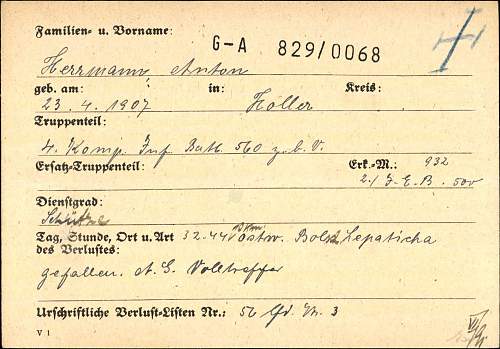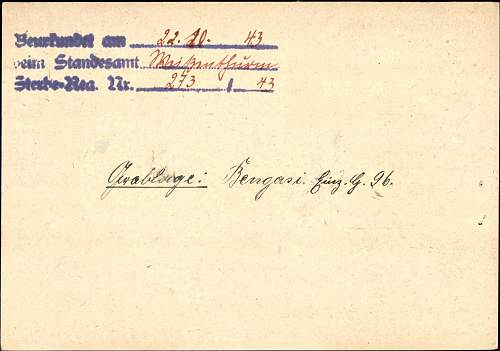-
03-15-2024, 05:56 PM
#951
-
03-15-2024 05:56 PM
# ADS
Circuit advertisement

-
03-15-2024, 05:59 PM
#952
-
03-29-2024, 06:23 PM
#953

The sterbebild of Anton Herrmann clearly illustrates the occasional practice of painting over a uniform onto a picture that presumably showed him in civilian dress originally.
-
03-29-2024, 07:35 PM
#954


by
BlackCat1982

The sterbebild of Anton Herrmann clearly illustrates the occasional practice of painting over a uniform onto a picture that presumably showed him in civilian dress originally.
Hi BC.
I wonder if he was not allowed to have an official uniform photo taken because he was in a punishment unit. Looking at his erkennungsmarke entry (2./Kompanie Infanterie Ersatz Bataillon 500), he might have been sent to this unit straight from civilian life. If this is not the case, maybe soldiers were issued a new erkennungsmarken when they were transferred as part of their punishment.
Kind regards,
Will.
Last edited by Willmore; 03-29-2024 at 08:44 PM.
-
03-30-2024, 05:00 PM
#955


by
Willmore

Hi BC.
I wonder if he was not allowed to have an official uniform photo taken because he was in a punishment unit. Looking at his erkennungsmarke entry (2./Kompanie Infanterie Ersatz Bataillon 500), he might have been sent to this unit straight from civilian life. If this is not the case, maybe soldiers were issued a new erkennungsmarken when they were transferred as part of their punishment.
Kind regards,
Will.
That is possible Willmore, although I've seen Wehrpaß issued to members of punishment battalions with portraits of the holder wearing uniform? It may also be that the family wanted to show that he'd died a soldiers death in combat for the Fatherland and as such was "entitled" to wear uniform. I don't suppose we will ever know, but it's an interesting item.
-
04-01-2024, 10:20 AM
#956

9./Batterie Marine Flak Abteilung 705 - Karl Seitz (Killed during Operation Chariot, the Commando raid on St Nazaire, France).

Name: Karl Seitz
Rank: Marine Artilleristen
Birth Date: 14 Dec 1921
Birth Place: Schwerstettin Ob Baÿern
Military Unit: Kdo 9./Batterie Marine-Flak-Abteilung 705
Death Date: 28 March 1942
Death Place: St Nazaire, France
His cause of death is simply noted as Gefallen (Killed in action)



Karl doesn't have an entry on the Volksbund.
Background of the raid -
Operation Chariot was an audacious Combined Operation raid on the port of St Nazaire in German occupied France. Packed with tons of high explosives, the destroyer, HMS Campbeltown, was rammed into the gates of the only dry dock capable of servicing the German battleship Tirpitz. Such was the damage, the dry dock was rendered unusable for the remainder of the war.
In the second week of January 1942, the powerful German battleship, Tirpitz, moved from the Baltic, through the Kiel canal and north to Trondheim on the Norwegian coast.
From there, it had the potential to break out into the North Atlantic and to wreak havoc on allied Atlantic convoys. C in C Home Fleet, Admiral Tovey, opined that to sink the Tirpitz would be "of incomparably greater importance to the conduct of the war than the safety of any convoy." Churchill shared this view, commenting that "the entire naval situation throughout the world would be altered."
Four separate attempts to bomb the Tirpitz failed, with the loss of 12 aircraft. A different strategy was required.
The Germans needed dry-dock facilities on the Atlantic coast, before the battleship could be deployed effectively against allied convoys and the only suitable port was St. Nazaire. It lay on the north bank of the River Loire about 6 miles from the river mouth, which itself was about 6 miles wide.
The Planning Division in the Admiralty, conceived the idea to destroy the lock gate at St Nazaire which would render the dry dock unusable.
Operation Chariot - St. Nazaire, 28th March 1942

Location of St Nazaire, France.
St Nazaire Raid - Wikipedia

Position of Marine Flak Abteilung 705 is circled in red, note its proximity to St Nazaire.
Estuary Approach
Marineflakabteilung 705 -
Formed in Saint-Nazaire-Montoir in the Pays de la Loire Region of France in May 1941. It was formed as Marineflakabteilung Koch but renamed Marineflakabteilung 705 in August 1941. The Abteilung was subordinate to the Seekommandant Loire, then to the 22. Marineflakregiment & finally to the V. Marineflakbrigade.
Marineflakabteilung 705
22. Marine-Flak-Regiment -
Formed 11.41 in St. Nazaire. In 4.43 redesignated V. Marine-Flak-Brigade. Consisted of:
Marine-Flak-Abteilung 703 (St. Nazaire)
Marine-Flak-Abteilung 705 (St. Nazaire)
Marine-Flak-Abteilung 809 (St. Nazaire)
Subordinated to Seekdt. Loire-Gironde
Marine-Flak-Regimenter - Feldgrau
Datasheet Air defence (Before 01-04-1943 the air defence was controlled by 22. Marine Flak Regiment) -
Note: The sources are contradictorily about the number of gunbatteries of 705 Marine Flak Abteilung. We believe there were 6 gunbatteries (1., 2., 3., 4., 5., 7.) and 1 searchlightbattery (6.). Number 7. gunbattery was located at Aine.
https://bunkersite.com/locations/fra...e/data-air.php
Outcome -
With the dry dock put out of action, the St Nazaire raid had been a success, but this was achieved at a high cost. Of the 612 men of the Royal Navy and commandos who took part in the raid, only 228 men returned to England. Five commandos escaped via neutral Spain and Gibraltar with the help of French citizens, 169 men were killed and 215 became prisoners of war.
The explosive charges in HMS Campbeltown detonated at noon on 28 March 1942 killing a party of 40 senior German officers and civilians who were on a tour of the vessel. It is estimated that German losses were 360 men killed during the raid, or by the subsequent explosion of the Campbeltown.
Additional information -
https://warfarehistorynetwork.com/ar...on-st-nazaire/
http://operation-chariot.org/
https://www.commandoveterans.org/Chariot
https://militaryhistorynow.com/2021/...int-nazaire-2/
https://www.commandoveterans.org/operation_chariot
Last edited by Willmore; 04-01-2024 at 11:08 PM.
-
04-03-2024, 11:47 AM
#957


by
BlackCat1982

The sterbebild of Anton Herrmann clearly illustrates the occasional practice of painting over a uniform onto a picture that presumably showed him in civilian dress originally.
Now that is something I never realised before. I had several Sterbebilder on which the collars looked retouched, and I always thought it was a cover-up during or after the war for some reason. But I never realised that a complete uniform was painted on the picture?
I had a few with clearly covered SS symbols, that made sense to me. Right after the war, it wasn't exactly something to advertise that your beloved one served with the criminalized SS.
Let me check if I still have one...
Martin
-
04-03-2024, 11:55 AM
#958


by
Martin3

Now that is something I never realised before. I had several Sterbebilder on which the collars looked retouched, and I always thought it was a cover-up during or after the war for some reason. But I never realised that a complete uniform was painted on the picture?
I had a few with clearly covered SS symbols, that made sense to me. Right after the war, it wasn't exactly something to advertise that your beloved one served with the criminalized SS.
Let me check if I still have one...
Martin
Hi Martin.
Here is an interesting side by side comparison of a before and after photo edit (from post #687).

Kind regards,
Will.
-
04-03-2024, 12:02 PM
#959
-
04-03-2024, 12:32 PM
#960






 .
.



















Bookmarks